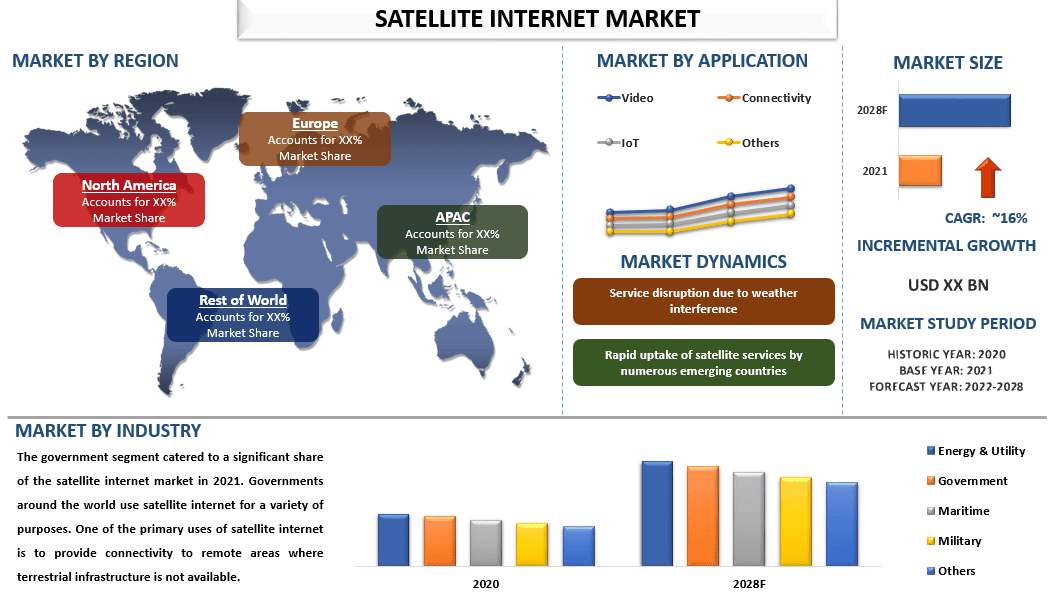- Home
- About Us
- Industry
- Services
- Reading
- Contact Us
Satellite Internet Market: Current Analysis and Forecast (2022-2028)
Emphasis on Component (Software and Services); Technology (Desktop Virtualization, Server Virtualization, and Data Center Virtualization); Industry (Information & Communication Technology, Banking & Financial Services, Aerospace & Defense, Healthcare, and Others); and Region/Country

The Satellite Internet Market stood at USD 8 Billion in 2022. It is projected to grow at a CAGR of 16.0% by 2028 owing to the lack of traditional internet infrastructure, mobility, reliability, and other factors. Satellite internet is a type of internet service that provides users with connectivity through a network of communication satellites that orbit the Earth. It is typically used in areas where traditional terrestrial Internet infrastructure such as cable or digital subscriber lines is not available or where the cost of setting up the required infrastructure is prohibitive. Satellite internet has grown in popularity in recent years as more people seek reliable internet connections in areas where traditional broadband services are either unavailable or too slow. Demand for satellite internet is increasing for a variety of reasons, including the expansion of remote work and the need for connectivity in rural areas. Moreover, satellite internet is also becoming more affordable and accessible, contributing to its growing popularity. Further on, advances in technology have made satellite internet more affordable, and many providers now offer competitive pricing plans that rival traditional broadband services. The rapidly growing number of internet users around the globe is another factor subsidizing the growth of the market. For instance, according to the World Bank, in 2020, 60% of the world’s population was using the internet and this percentage increased to 69% (around 4.9 billion people) in 2022.
Some of the major players operating in the market include Singtel; EUTELSAT COMMUNICATIONS SA; Oneweb.net; SPACEX; Viasat, Inc.; EchoStar Corporation; Embratel; Airtel India; DSL Telecom; and Hispasat Several M&As along with partnerships have been undertaken by these players to facilitate customers with hi-tech and innovative products/technologies.
Insights Presented in the Report
“Amongst band type, the K – band held a prominent share of the market in 2021”
Based on the band type, the market is segmented into C – band, X – band, L – band, K – band, and others. Amongst these, the K – band segment held the major share of the market in 2021. The use of K-band frequency is on the rise in various fields like defense, broadcasting, and security radar systems. An upcoming trend in K-band technology is K – band monolithic microwave integrated circuit (MMIC), which makes it possible to develop K-band power amplifiers and low-noise amplifiers at a lower cost, and with ease of large-scale production and high durability. This trend is expected to fuel the growth of the market in the predicted period.
“Amongst application, IoT segment held a dominating share of the market in 2021”
By application, the market is divided into video, connectivity, IoT, and others. Among these, the IoT application segment captured a significant share of the satellite internet market in 2021 and is expected to grow at a strong CAGR during the forecasted period owing to the rising applications of satellite internet in IoT and the growing number of IoT devices globally. In IoT applications, satellite internet can be used to connect various devices, including sensors, cameras, and other smart devices, to a central system or server for data analysis, storage, and control.
“North America dominated the market in 2021”
North America captured a dominating share of the market in 2021 and is expected to grow at a strong CAGR during the forecast period. One of the most prominent factors driving the growth of the market is the inadequate availability of traditional broadband services, particularly in rural areas where infrastructure is limited, and internet service providers are far away. This makes it difficult for residents to access high-speed internet. However, satellite internet provides an effective solution as it can be used to connect remote locations without the need for physical infrastructure. Further on, advancements in technology have made satellite internet more accessible and affordable.
Satellite Internet Market Report Coverage

Reasons to buy this report:
- The study includes market sizing and forecasting analysis validated by authenticated key industry experts.
- The report presents a quick review of overall industry performance at one glance.
- The report covers an in-depth analysis of prominent industry peers with a primary focus on key business financials, product portfolios, expansion strategies, and recent developments.
- Detailed examination of drivers, restraints, key trends, and opportunities prevailing in the industry.
- The study comprehensively covers the market across different segments.
- Deep dive regional level analysis of the industry.
Customization Options:
The global satellite internet market can further be customized as per the requirement or any other market segment. Besides this, UMI understands that you may have your own business needs, hence feel free to connect with us to get a report that completely suits your requirements.
Table of Content
Research Methodology for the Satellite Internet Market Analysis (2022-2028)
Analyzing the historical market, estimating the current market, and forecasting the future market of the global satellite internet market were the three major steps undertaken to create and analyze the adoption of satellite internet in major regions globally. Exhaustive secondary research was conducted to collect the historical market numbers and estimate the current market size. Secondly, to validate these insights, numerous findings and assumptions were taken into consideration. Moreover, exhaustive primary interviews were also conducted, with industry experts across the value chain of the global satellite internet market. Post assumption and validation of market numbers through primary interviews, we employed a top-down/bottom-up approach to forecasting the complete market size. Thereafter, market breakdown and data triangulation methods were adopted to estimate and analyze the market size of segments and sub-segments of the industry pertains to. Detailed methodology is explained below:
Analysis of Historical Market Size
Step 1: In-Depth Study of Secondary Sources:
Detail secondary study was conducted to obtain the historical market size of the satellite internet market through company internal sources such as annual reports & financial statements, performance presentations, press releases, etc., and external sources including journals, news & articles, government publications, competitor publications, sector reports, third-party database, and other credible publications.
Step 2: Market Segmentation:
After obtaining the historical market size of the Satellite Internet market, we conducted a detailed secondary analysis to gather historical market insights and share for different segments & sub-segments for major regions. Major segments are included in the report as band type, application, and industry. Further country-level analyses were conducted to evaluate the overall adoption of testing models in that region.
Step 3: Factor Analysis:
After acquiring the historical market size of different segments and sub-segments, we conducted a detailed factor analysis to estimate the current market size of the satellite internet market. Further, we conducted factor analysis using dependent and independent variables such as band type, application, and industry of the satellite internet market. A thorough analysis was conducted for demand and supply-side scenarios considering top partnerships, mergers and acquisitions, business expansion, and product launches in the Satellite Internet market sector across the globe.
Current Market Size Estimate & Forecast
Current Market Sizing: Based on actionable insights from the above 3 steps, we arrived at the current market size, key players in the global satellite internet market, and market shares of the segments. All the required percentage shares split, and market breakdowns were determined using the above-mentioned secondary approach and were verified through primary interviews.
Estimation & Forecasting: For market estimation and forecast, weights were assigned to different factors including drivers & trends, restraints, and opportunities available for the stakeholders. After analyzing these factors, relevant forecasting techniques i.e., the top-down/bottom-up approach were applied to arrive at the market forecast for 2028 for different segments and sub-segments across the major markets globally. The research methodology adopted to estimate the market size encompasses:
- The industry’s market size, in terms of revenue (USD) and the adoption rate of the satellite internet market across the major markets domestically
- All percentage shares, splits, and breakdowns of market segments and sub-segments
- Key players in the global satellite internet market in terms of products offered. Also, the growth strategies adopted by these players to compete in the fast-growing market
Market Size and Share Validation
Primary Research: In-depth interviews were conducted with the Key Opinion Leaders (KOLs) including Top Level Executives (CXO/VPs, Sales Head, Marketing Head, Operational Head, Regional Head, Country Head, etc.) across major regions. Primary research findings were then summarized, and statistical analysis was performed to prove the stated hypothesis. Inputs from primary research were consolidated with secondary findings, hence turning information into actionable insights.
Split of Primary Participants in Different Regions
Market Engineering
The data triangulation technique was employed to complete the overall market estimation and to arrive at precise statistical numbers for each segment and sub-segment of the global satellite internet market. data was split into several segments & sub-segments post studying various parameters and trends in the areas of the band type, application, and industry in the global satellite internet market.
The main objective of the Global Satellite Internet Market Study
The current & future market trends of the global satellite internet market were pinpointed in the study. Investors can gain strategic insights to base their discretion for investments on the qualitative and quantitative analysis performed in the study. Current and future market trends determined the overall attractiveness of the market at a regional level, providing a platform for the industrial participant to exploit the untapped market to benefit from a first-mover advantage. Other quantitative goals of the studies include:
- Analyze the current and forecast market size of the satellite internet market in terms of value (USD). Also, analyze the current and forecast market size of different segments and sub-segments
- Segments in the study include areas of the band type, application, and industry
- Define and analysis of the regulatory framework for the satellite internet industry
- Analyze the value chain involved with the presence of various intermediaries, along with analyzing customer and competitor behaviors of the industry
- Analyze the current and forecast market size of the satellite internet market for the major region
- Major countries of regions studied in the report include Asia Pacific, Europe, North America, and the Rest of the World
- Company profiles of the satellite internet market and the growth strategies adopted by the market players to sustain in the fast-growing market
- Deep dive regional level analysis of the industry
Related Reports
Customers who bought this item also bought










